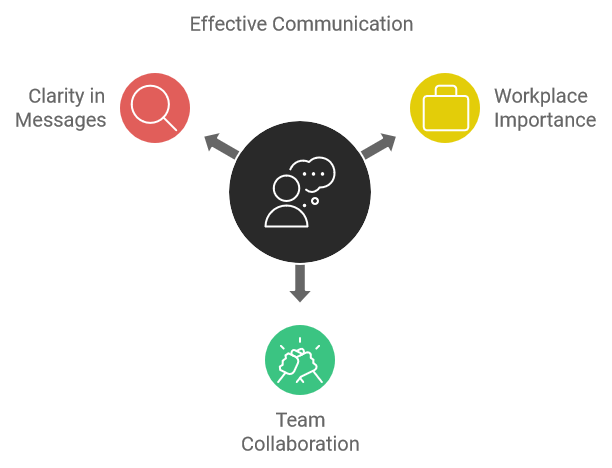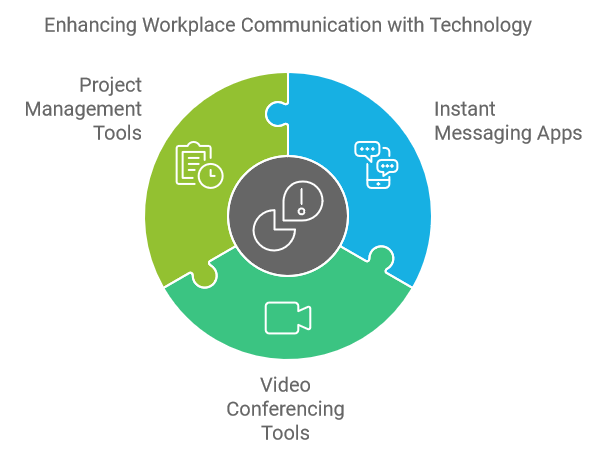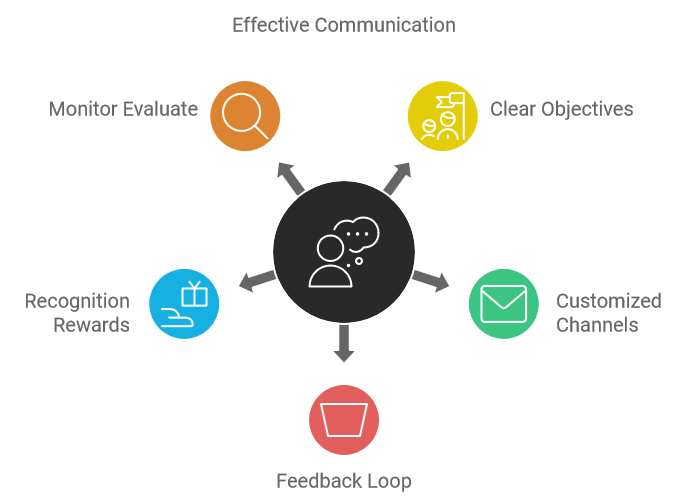Understanding Effective Communication in the Workplace
In this article, you will learn about effective communication in the workplace is vital. Learn strategies to enhance employee communication in call centers and BPOs.
5 min read
Effective communication in the workplace is the cornerstone of a productive and cohesive environment. For call centers and BPOs, this is especially significant, given the diverse and often dispersed nature of their workforce. Miscommunication can lead to operational inefficiencies, employee dissatisfaction, and ultimately, a negative impact on the company’s bottom line.
According to a 2021 report by McKinsey, companies with effective communication practices are 50% more likely to have lower employee turnover rates, which is a critical factor in high-stress environments like call centers and BPOs. Furthermore, a Gallup study found that employee engagement, which is highly influenced by communication, can lead to a 21% increase in profitability for organizations.
These statistics underscore the importance of fostering an environment where clear, consistent, and effective communication is prioritized.
For CXOs, HR managers, and operations managers, improving communication within the workplace is not just about avoiding misunderstandings. It’s about creating a culture where information flows seamlessly, employees feel valued and understood, and the organization as a whole can operate more efficiently.
In this blog post, we will delve into practical strategies and tips to enhance employee communication effectively.
What Is Effective Communication and Its Importance in The WorkPlace?

Effective communication in the workplace refers to the ability to convey information to others in a clear, concise, and unambiguous manner. It also involves receiving information from others assertively and empathetically. In the context of the workplace, especially in call centers and BPOs, it’s crucial as it enables employees to understand their roles, responsibilities, and the expectations from them clearly.
Research by Harvard Business Review highlights that effective communication can lead to improved employee performance as it helps in avoiding misunderstandings, reducing errors, and building stronger team cohesion. Moreover, it encourages a feedback culture, where employees feel comfortable sharing their thoughts and concerns, thus promoting an inclusive workplace.
Pro Tip
Encourage open communication by having regular team meetings and one-on-one discussions to ensure everyone is on the same page and feels heard.
Challenges in Achieving Effective Communication in Contact Centers and BPOs

Call centers and BPOs face unique challenges when it comes to effective communication due to their operational structure and high employee turnover rates. Here are some of the common obstacles:
- Geographical Dispersal: Teams may be spread across different locations, making real-time communication challenging.
- High Turnover Rates: Frequent changes in staff can disrupt communication flows and require constant retraining.
- Different Time Zones: Coordinating meetings and information-sharing across varying time zones can be difficult.
- Cultural Barriers: Diverse backgrounds can lead to misunderstandings if cultural differences are not managed well.
Pro Tip
Use collaboration tools like Slack or Microsoft Teams, which provide instant messaging, video calls, and file sharing, to bridge communication gaps efficiently.
Strategies to Enhance Communication in the Workplace

1. Leverage Technology for Real-Time Communication
In the digital age, technology plays a pivotal role in enhancing workplace communication. Tools like instant messaging apps, video conferencing software, and project management platforms are indispensable for call centers and BPOs.
According to a study by Buffer, 75% of remote workers find instant messaging apps crucial for maintaining effective communication.
Instant Messaging Apps: Slack, Microsoft Teams, and WhatsApp are excellent for real-time communication and quick decision-making.
Video Conferencing Tools: Platforms like Zoom and Google Meet allow for virtual face-to-face interactions, which can be more personal and engaging than emails or messages.
Project Management Tools: Project management tools like Asana, Trello, and Monday.com help teams to stay organized, meet deadlines, and communicate project progress effectively.
Pro Tip
Integrate these tools with your company's existing CRM or ERP systems to ensure seamless workflow and information sharing.
2. Foster a Culture of Open Communication
Creating a culture where open communication is encouraged can significantly enhance employee engagement and satisfaction.
According to a report by Deloitte, companies that promote open communication are 4.5 times more likely to retain their best employees.
Regular Team Meetings: Weekly or bi-weekly meetings can help keep everyone informed and foster a sense of belonging.
Feedback Mechanisms: Implementing feedback systems like suggestion boxes, surveys, and regular performance reviews encourages employees to voice their opinions.
Transparent Leadership: Leaders should model open communication by regularly updating the team on company goals, performance, and changes.
Pro Tip
Implement a "town hall" style meeting where employees can ask questions directly to leadership, fostering transparency and trust.
3. Invest in Training and Development
Effective communication is a skill that can be developed with proper training and practice. Investing in communication training can yield significant returns in the form of improved performance and employee satisfaction.
According to LinkedIn’s Workplace Learning Report, 94% of employees would stay at a company longer if it invested in their career development.
Communication Workshops: Regular workshops can help employees develop skills such as active listening, clear messaging, and effective feedback.
Role-Playing Exercises: These can be particularly useful in call centers, helping agents practice handling difficult conversations and improving their communication skills.
Online Courses: Platforms like Coursera and Udemy offer courses on communication skills that can be beneficial.
Pro Tip
Pair new employees with communication mentors who can provide ongoing support and guidance as they integrate into the company.
4. Utilize Data and Analytics
Data and analytics can provide valuable insights into communication patterns within your organization. By analyzing data, you can identify bottlenecks, understand employee sentiment, and make informed decisions to improve communication strategies.
According to Gartner, companies that leverage data and analytics in their communication strategies see a 20% increase in employee engagement.
Communication Audits: Regularly review internal communication channels to identify gaps and areas for improvement.
Employee Surveys: Conduct surveys to gather feedback on communication practices and identify areas needing attention.
Performance Metrics: Use performance data to identify how communication impacts employee productivity and satisfaction.
Pro Tip
Use sentiment analysis tools to gauge employee mood and morale from communication channels like emails and instant messages.
5. Promote Inclusivity and Diversity
Inclusivity and diversity play a crucial role in effective communication. A diverse workforce brings varied perspectives, leading to more innovative solutions and better decision-making.
According to a report by McKinsey, companies with diverse workforces are 35% more likely to have financial returns above their respective national industry medians.
Diverse Hiring Practices: Ensure your hiring practices promote diversity and inclusivity to bring varied perspectives to the team.
Cultural Sensitivity Training: Provide training to help employees understand and respect cultural differences, promoting better communication.
Inclusive Communication Channels: Use multiple communication channels to ensure all voices are heard, regardless of their role or location.
Pro Tip
Celebrate cultural diversity through regular events and activities to foster an inclusive workplace environment.
Tips for Implementing Effective Communication Strategies in The Workplace

1. Set Clear Objectives
Before implementing any communication strategy, it’s important to set clear objectives. What do you want to achieve? Whether it’s reducing errors, improving employee morale, or increasing productivity, having clear goals will help you measure the effectiveness of your strategies.
According to a study by SHRM, clear communication of objectives can lead to a 24% increase in employee performance.
Pro Tip
Use the SMART framework for setting objectives - Specific, Measurable, Achievable, Relevant, and Time-bound.
2. Customize Communication Channels
Different teams and departments may have different communication needs. Customizing your communication channels to suit these needs can enhance effectiveness significantly.
For example, sales teams may benefit more from instant messaging for quick updates, while development teams might prefer detailed emails for technical discussions.
Pro Tip
Conduct a needs assessment to understand the preferred communication channels of different departments and adapt accordingly.
3. Encourage a Feedback Loop
A feedback loop is essential for continuous improvement. Encourage employees to provide feedback on the communication strategies in place and make adjustments as needed.
According to a report by Gallup, managers who received feedback on their strengths showed a 12.5% greater productivity increase than those who did not.
Pro Tip
Create an anonymous feedback system to allow employees to share their thoughts without fear of retribution.
4. Provide Recognition and Rewards
Recognizing and rewarding effective communication can motivate employees to maintain high standards and continuously improve their skills.
According to a study by Globoforce, 78% of employees said being recognized motivates them in their job.
Pro Tip
Implement an 'Employee of the Month' program that specifically recognizes outstanding communicators in your organization.
5. Monitor and Evaluate
Finally, it’s essential to monitor and evaluate the effectiveness of your communication strategies regularly. Use KPIs and other metrics to assess performance and make necessary adjustments.
According to a survey by PwC, 71% of organizations that effectively monitor their communication strategies report higher performance compared to their peers.
Pro Tip
Use dashboards and reporting tools to track communication metrics and visualize data for better decision-making.
Conclusion
Effective communication in the workplace is not a one-time initiative but an ongoing effort to create an environment where information flows seamlessly and employees feel valued empowered.
For call centers and BPOs, where the stakes are even higher, prioritizing communication can lead to significant improvements in performance, employee satisfaction, and ultimately, the company’s bottom line.
By leveraging technology, fostering a culture of open communication, investing in training, utilizing data, and promoting inclusivity, you can transform your organization’s communication practices and achieve lasting success.
Remember, the key to effective communication lies in understanding the unique needs of your workforce and continually adapting your strategies to meet these needs. Start implementing these tips today and watch as your organization thrives.
Start your outsourcing company’s transformation today!
Say hello to productivity, accuracy, and profitable growth. Streamline your operations and project management with HiveDesk.



